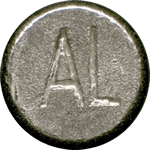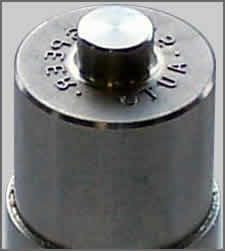Home | Glossary | Resources | Help | Contact Us | Course Map
Archival Notice
This is an archive page that is no longer being updated. It may contain outdated information and links may no longer function as originally intended.
Rimfire
Rimfire cases start as rolled, thin sheets of cartridge brass, which are mounted and fed through rollers to reflatten them.
The sheet moves into a cupping press that
- lubricates the sheets,
- blanks out disks of brass,
- drives the disks into a cupping die to form shallow cups.
A draw press reduces the diameter and increases the length of the cup in the same manner as copper bullet jackets. The punch and die set in the draw press captures all surfaces of the cup except the base (closed end) and stretches the brass to the desired diameter. The drawn length is longer than that required for the finished case to allow trimming the case mouth to uniform length. The inside of the case mouth may be beveled during trimming to facilitate bullet seating.
At this point, the case has a finished diameter and case mouth, but the closed end is not shaped into a functional case head. The heading operation shapes the closed end using a press called a header.
Heading accomplishes the following:
- Forms the rim and rim cavity (for holding the priming charge)
- Sets the rim diameter
- Sets the rim thickness
- Sets the final case length
- Applies the identifying headstamp
In most factories, all of the heading processes can be accomplished in a single operation. The case is held securely in a stationary die; an inner back-up punch and an outside forming punch come together to apply the required force. The outer punch ( bunter) has raised characters on the punch that impress the headstamp into the base.
After cold working, the brass may have residual stresses, which may affect the long-term performance and safety of the case. This contributes to age hardening. Stress relief ovens raise the metal temperature enough to relax the stresses without changing the grain structure of the case.
The rimfire case is fully formed, but covered in oils that could contaminate the priming compound. Washing removes these oils, leaving water in its place. The cases must be oven dried to remove all traces of moisture.
See the YouTube Terms of Service and Google Privacy Policy
Centerfire
Similar to rimfire cases and metal bullet jackets, most centerfire cases start as cups. Since the raw sheet brass required for these cases is often thicker than that used for rimfire cases, preformed cups are frequently purchased by the manufacturer.
Drawing is the most widely used method in the manufacture of brass cases. It reduces diameter and increases length and is the best method for case fabrication. There is little difference in tooling between case-drawing dies and those used to make bullet jackets.
Depending on the length of the finished case, the cup may be drawn from one to five times. For cases requiring three to five draws, an intermediate stress relief heat treatment may be applied to keep the material ductile. The dies and punches maximize the diameter and length and fully shape the cavity. This profile defines the wall thickness of the finished part. The case will be thinnest at the mouth to allow flexibility for holding the bullet. To withstand firing pressures, the walls will be thickest at the closed end.
Drawing Operations
The draw operation leaves enough material in the base to form the web of the case. The web provides support for the primer and reduces the amount of swelling that can occur during firing.
After drawing, the cylinder is closed at one end, leaving extra material in the closed end. That end is convex after drawing; the draw dies work only the metal in the walls of the case. The next operation flattens the base, squaring it and applying the head stamp.
Heading also forms the rim for a rimmed case or removes the excess material when creating a rimless case. Heading forms a primer pocket in the web. The cylindrical case is mounted in a die to prevent changes in diameter; a support punch is placed inside the case to resist the blow of the bunter. The bunter has a central protrusion that will form the primer pocket (the recess that accepts primer during cartridge assembly).
If the case is to have a protruding rim (e.g., 30-30 Winchester), the supporting die requires a step in the end facing the bunter. The step allows all of the extra metal to flow toward the end and creates the mass of material that will eventually form the rim. The die that supports a rimless case (e.g., 5.56 mm NATO) has a slight enlargement at the exact same point. This enlargement provides that there is plenty of extra metal to ensure that subsequent operations keep the case head concentric.
Additional Online Courses
- What Every First Responding Officer Should Know About DNA Evidence
- Collecting DNA Evidence at Property Crime Scenes
- DNA – A Prosecutor’s Practice Notebook
- Crime Scene and DNA Basics
- Laboratory Safety Programs
- DNA Amplification
- Population Genetics and Statistics
- Non-STR DNA Markers: SNPs, Y-STRs, LCN and mtDNA
- Firearms Examiner Training
- Forensic DNA Education for Law Enforcement Decisionmakers
- What Every Investigator and Evidence Technician Should Know About DNA Evidence
- Principles of Forensic DNA for Officers of the Court
- Law 101: Legal Guide for the Forensic Expert
- Laboratory Orientation and Testing of Body Fluids and Tissues
- DNA Extraction and Quantitation
- STR Data Analysis and Interpretation
- Communication Skills, Report Writing, and Courtroom Testimony
- Español for Law Enforcement
- Amplified DNA Product Separation for Forensic Analysts




